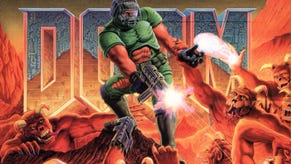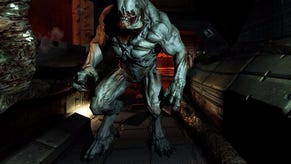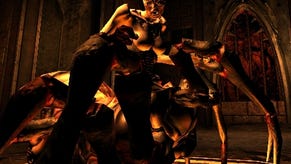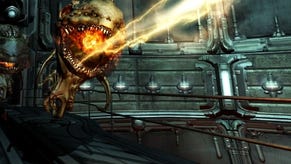Doom III
Selling Hell proves fittingly difficult. You kind of have to go there first.
Order yours now from Simply Games.
I suppose the Hellish irony about Doom III for somebody who likes it is that it's very difficult to evangelise convincingly. It seems to have proved so divisive on the PC precisely because everyone did get it; we were all just divided by personal taste. The things I now like about it are the things that other people hate. Watch!
As you know by now, it's a pretty straightforward/linear first-person haunted house ride designed with a big Satanic twist and, you know, on Mars. The chief thrill/problem is the compulsive/repetitive cycle of creeping around in the dark waiting for things to go boo/make you groan, and then trying to find somewhere to back away firing your gun happily/frowningly until they die. It would be relentless were it not for the fun/incongruity of having to collect dead staffers' PDAs, cleverly utilised/cynically disguised as key cards for opening doors, and perusing email and voice logs for key codes and plot detail.
To me, Half-Life 2 was far more progressive and inventive; a much purer first-person shooter. id's creation basks in its survival horror influences, making sure it puts things behind you whenever they jump up in front, and forcing you to sacrifice your oft-needed torch-beam in order to fire on them. But in generic FPS terms it sticks doggedly to mechanics that already worked. It just makes sure that it does them bloody solidly, and if you succumb to the lure of the main mechanic and enjoy soaking up the dark themes in the dark, then you'll become more and more enamoured with it as things escalate further into the game.
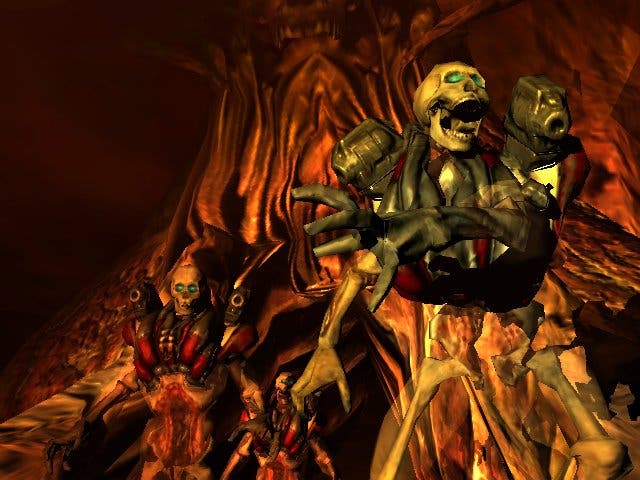
But hey! We're on the Xbox! Different playing field; different competition. You're probably wondering how this stacks up against the likes of Riddick and Halo. Well, again, it's not really in the same cast. Halo is a phenomenon that I don't pretend to completely understand, but I do know this is not much like Halo, which aims for a sci-fi war feel. Doom III is more like the sci-fi equivalent of Theseus stumbling through a labyrinth of a million Minotaurs. And Riddick is almost the exact reverse of Doom III. It has the darkness in common, and the high-resolution graphics, but there it's the player who's going "boo!" on unsuspecting grunts and not the other way round.
Another thing Doom III definitely isn't is the overwhelming onslaught of innumerable demonic aggressors that fans of the first two games probably wanted. It gets noticeably more intense about halfway through and then ramps up to a decent crescendo with a fairly rip-roaring final third, but although there are some extraordinary sights to behold, truly monstrous demons to vanquish, and the requisite number of mad scientists in this world and the next (on all three counts), most of the fighting is done in dark corridors and research base interiors with the lights at least mostly off, and it's rarely overwhelming. Played on Normal, ammo is sometimes scarce, and the things-going-bump set-pieces catch you off-guard from time to time, but on the whole the combination of a proper PC-style quick-save function and a very forgiving aiming assist means you can make it pretty much to the end without becoming massively frustrated by the odds.
Having you worry about your actual well being rather than just spiking your heart rate might have been preferable, but it probably would have alienated more of the people who actually like it, so instead it's content to just be wonderfully good at what it's trying to do. It doesn't resort to too many of other people's clichés - it's rife with crawling around in vents, Half-Life-style, for example, but it's a very rare thing to be ambushed by some leaping nasty as you crawl around them - preferring instead to build up a tense atmosphere in the dark and then make you jump out of your skin whenever it can. Then it gives you pause to let your heart settle back down, breaking things up along its very singular path by letting you read dead people's PDAs, which unlock ammo caches and serve as keys for opening doors - a barrier to progress, but not in the needle-in-a-haystack manner of the originals. Then it spikes you again. A bit like walking towards the light whilst being electro-shocked by the people trying to revive you, perhaps. Sometimes it rewards your frenzied state by parading lots of the increasingly innocuous zombie types and letting you either rev the chainsaw or run around with your fists in crazed berserker mode - and it always has you shouting manically at the TV when it does this.
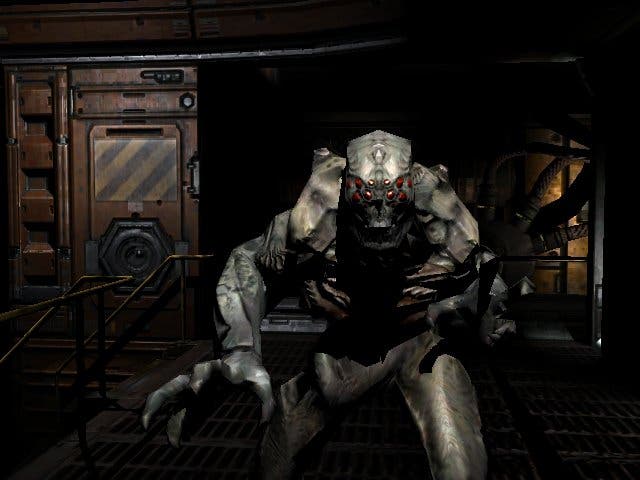
I can't emphasise the dark enough, to go back to that. It's so central that one of the most divisive elements of the message board rows surrounding its release on the PC was the flashlight, which you have to put away to get your gun out, often forcing you to fight in the dark. The game starts off in a manner now familiar to PC first-person fans - a nameless grunt is thrown speechlessly into a narrative primer, poorly but welcomely disguised as a fairly normal report-for-duty-and-start-patrol scenario, before events take a hooorrible turn for the worse and require a lot of blasting to turn back. It feels a bit like Half-Life at this point. But when things do go so extensively wrong you happen to be in the basement in the dark, and it's a sensation that dominates the make-up of the game, underscoring the torch issue. Which (and here comes another slashing sentence, for those of you still reeling from the slash overload of the second paragraph) feels like it's heightening the tension and excitement factor/a cheap trick drawn out rather longer than is tolerable.
Thanks to Vicarious Visions' immensely impressive porting skills, Doom III's manages to deliver on what ambition it does have very well on the Xbox, carving its chilling sights convincingly out of the shadows with striking detail - the goalpost-shifting normal mapping technique applied convincingly again in combination with frugal but very effective use of light and shadow. Most things have a slightly unconvincing, sort of accidentally stylistic curvy look to them, but you grow to like that. I also grew to really like the chilling sights I mentioned, although these are more kind of woah-yeah-Revenant-HAVE-SOME! shouting jumpy encounters than anything else. You know, bodies getting fired out of vents and groans scraping like fingernails down the blackboard of your eardrums before they pounce. Floating demonic heads that spit flame, imps chucking plasma, stomping bull-demons, winged baby corpses. And when it is spooky rather than sparky, it's usually just for show, like a corridor dominated by an enormous, unmoving slug-like tentacle, which rather appropriately reminded me of Shub-Nigurath from Quake. All ludicrous but all very fitting.
The chilling/jumpy difference is a good clarification to have to make, actually, because it reminds me about the surround sound. Surround sound isn't something I often pick up on, because in all honesty I don't often notice it, but not only did I notice it in Doom III, I really needed it. It seems to work better than the headphone option, in fact. And it's key to the constant fright of spinning round to meet a leaping malformed demonic beast, which, as I keep saying, is what Doom is doing so well/so repetitively.

It reels off these bump-in-the-night scenarios in an increasingly gory and devilish manner, gradually coaxing you into the heart of a farfetched yarn about the dangers of meddling with big red things on the other side of portals. And by the time it hits the high notes later on - including the descent into Hell itself, perhaps best immortalised by the realisation that it prompts far more blasphemous exclamation of the "Jesus Christ" variety than virtually any other FPS level in living memory - if you're enjoying it you're going to soldier on to the end with a big smile on your whitening face.
With all that in mind, it's actually pretty easy to determine whether you'll like it or not. The bottom line is that it's not very intellectual, inspiring or inventive, but that it's probably going to appeal to the sort of people who like watching scary films late at night, and it'll definitely strike a chord with anybody who holds a film like The Omen in high esteem; whether you're religious or not, there's something far more intense about the prospect of an eternal force for evil that's breaking through into our world when you know that half the planet actually believes in it, and you occasionally wonder if they're right. I'm not saying that the real Hell features skeletal warriors with rocket launchers on their shoulders; but the fact that it is Hell trying to break loose means the game makes a deeper impression on a receptive psyche. So, it's like Doom but with less (albeit more detailed) demons. You must know if that appeals or not.
I've already mentioned its technical achievements in graphical and audio terms, of course, but it's also worth paying tribute to the way the game feels. Vicarious Visions has - following on from its Jedi Knight ports - managed to turn out a dual analogue control system that feels really right. It's a bit difficult to turn around quickly on the spot sometimes, but you could argue that that's pretty important to the mood anyway (after all, you can only look one way at a pitch black T-junction), and otherwise it's very comfortable after a few hours' use. Reload's on X, the flashlight is on the white button, which feels pretty right, you hold the left trigger down to sprint, and there's also the option to bind your favourite weapons to D-pad directions. So, weapon and item switching and use in the dark is very easily picked up, and the weapons themselves are mostly very satisfying (you'll learn to love pretty much all of them, in fact), leaving you to interface with the adventure instead of wrestling with the interface.
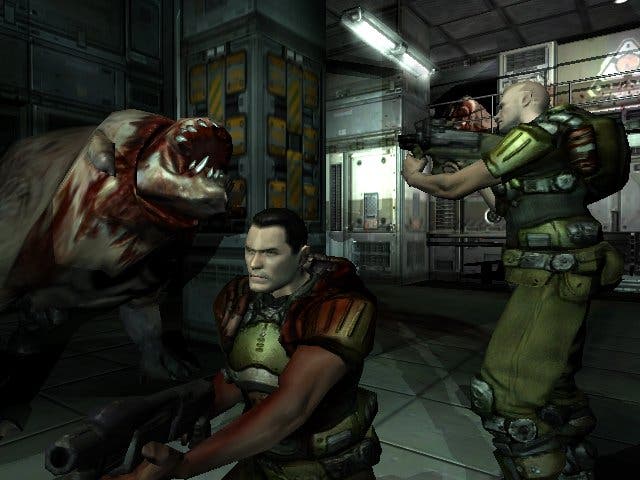
There are some silly interface issues, mind, like the way you can wind up digging out your PDA in the middle of something, which takes a few seconds; that most door panels involve getting close enough then using your fire button to operate a mouse pointer, which sometimes goes loudly wrong in the manner you're probably imagining; and, perhaps stupidest of all, that hitting Start on the pause menu immediately reloads the level you're on, leaving you to cry into the load screen. But these things can be forgiven if you're one of the people who falls on my side of the opinion divide.
The wildcard aspect, as those who've been following its development well know, is the game's Xbox Live co-operative campaign. (Notice I don't say "multiplayer modes" - this is because the standard competitive levels and gameplay modes feel rather too much like an afterthought and don't tie in particularly well with the feel of the game. If you want competitive multiplayer FPS gaming, you'll be much better equipped with either Halo 2 or TimeSplitters 3.) The lack of split-screen options is disappointing, but it goes to the other extreme online - the co-op campaign, for a pair of players, features around two thirds of the game widened slightly and reworked with more enemies and switches and munitions dumps specific to each player, and although lag and slowdown sometimes conspire to upset things, it's a social event, so suspension of disbelief doesn't enter into it; like a big, long, gory and explosive tandem bicycle ride into the depths of Mars. The real downside to it, in my view, is that you really have to experience the extensive single-player game first, and unfortunately having done that you might be left wanting a breather from those same scenarios before linking arms with anyone.
And that, for me, is one of the things that even people who like it will admit is principally disappointing: it's pretty much a one-way trip, and probably a bit too long with too much faffing before it all goes red. Riddick, Halo, Half-Life 2 - these are games you can play again and again and find new things. In Doom III it's hard to find anything fundamentally new on the second level. It does bigger and redder, but it doesn't do much in the way of variation. Whether you should buy it or not is a question of whether you like what it isn't varying.


